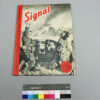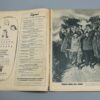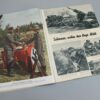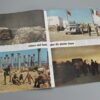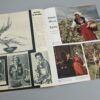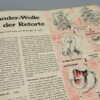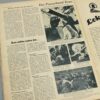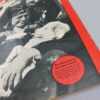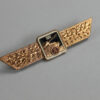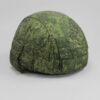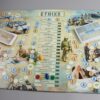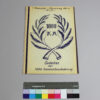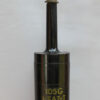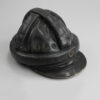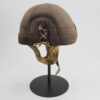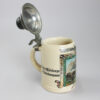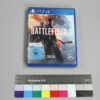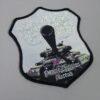Signal magazine 1941
Inventory number: Ü 371
Propaganda in times of war was not only directed at its own population: as early as the First World War, the German Reich published magazines in several languages that were intended to influence public opinion abroad. These efforts were intensified during the Second World War: Not only the newly created “Reich Ministry for Public Enlightenment and Propaganda” and the “Reich Propaganda Directorate” of the NSDAP were responsible for this, but for foreign countries above all the Foreign Office and also the Wehrmacht.
The foreign magazine “Signal” was a richly illustrated and well-received product of Nazi propaganda. Deutsche Verlag published it from April 1940 to March 1945 as a special edition of the “Berliner Illustrirte Zeitung” in cooperation with the Office for Wehrmacht Propaganda in the High Command of the Wehrmacht and, at the beginning, the Foreign Office. Renowned Nazi journalists and photographers worked for the magazine; the printing and layout were in keeping with the times and were based on the American magazine “Life”.
The “Signal” was not a free troop magazine, so its main target group was not German soldiers. They had to buy the magazine regularly at newsstands in the occupied countries, if available. Only a few issues were distributed free of charge in German embassies, legations and military hospitals abroad. The main outlets for this “German Wehrmacht sympathy offensive” were neutral foreign countries, as well as friendly and occupied countries and territories.
It was usually published twice a month and contained forty pages, with eight color pages. At the peak of its circulation at the end of 1942, the total circulation was 2.4 million copies. This high figure was mainly due to the constant addition of new language editions, which were often hastily published and poorly translated. In the first edition, the magazine was published in German, French, English and Italian, but more and more were added as the war progressed. By 1945, a total of 25 language editions had been published, some of which were only produced for a short time and in small print runs. Added to this was the unrivaled low price that commercially operating magazines could not achieve. Despite high sales figures and advertisements, the magazine was a loss-making business for Deutscher Verlag due to the high production costs, which is why the Wehrmacht subsidized it.
Depending on the war situation, the content of the magazines ranged from a quarter to half military topics, propaganda on the economic and social successes of the Nazi state, but also light entertainment such as popular science articles, cultural reports and, of course, photos of beautiful landscapes and women. Catholic Italy temporarily banned the publication of the magazine on the grounds that the photos were too revealing; attempts by Romania to ban the magazine on the grounds of propaganda content failed. The magazine was aimed at an international readership, but the editors did not skimp on stereotypical themes of Nazi propaganda such as racist photo series and captions on “sub-humans” and anti-Semitic texts on “Jewish plans for world domination”. Until the fall of 1942, the content of all language editions was the same; only then did the editors create “substitute pages”, and the Russian-language “Signal”, which was primarily aimed at so-called “Eastern workers” and “those willing to help” as well as Soviet collaborators, was given very different content.
On the cover of the November 1941 issue, two soldiers cheer behind an anti-tank gun: “Victory! The crew of a German Pak has destroyed another Soviet tank. (…) They have contributed to the decision in Eastern Europe”. However, the Wehrmacht was still a long way from a decision in the war of annihilation against the Soviet Union in the winter of 1941; the hoped-for quick victory had not materialized. The inside of the magazine only shows successes that were intended to fuel hopes of capturing Moscow despite the complete exhaustion of the German Eastern Army in terms of personnel and material and the onset of winter: Photo series of piles of wreckage of Soviet vehicles after the battle near Kiev, of captured Soviet soldiers with their hands raised and a report on their allegedly humane treatment in German POW camps: “Although they were told immediately after their capture that no one would be shot, the whispers of the Political Commissars (…) are still too fresh and too deep in their brains for them to believe in the self-evidence of humane treatment of prisoners by the Germans.” They had no reason to: the German “Order for the Treatment of Soviet Prisoners of War” excluded their treatment in accordance with the Geneva Convention. Millions of Soviet prisoners of war in the custody of the Wehrmacht died; the aforementioned political commissars often did not even reach the camps, as they were shot immediately after capture when the commissar order was implemented. The Signal offered a distraction from military topics with popular science texts, photo series of beautiful women from allied countries and the story of a dog puppy that a tank crew “rescued from a burning house during an attack”. Who originally set the house on fire is not reported.
After the war, many of the former “Signal” editors were able to continue their work in the illustrated magazine “Quick”, which was published from 1948 to 1992.
This text was automatically translated using AI.
Object of the month
(short) stories from the depot
Unfortunately, many objects cannot currently be shown in the exhibition for conservation reasons. Here you will find unusual objects and exciting stories of special pieces from the depot

